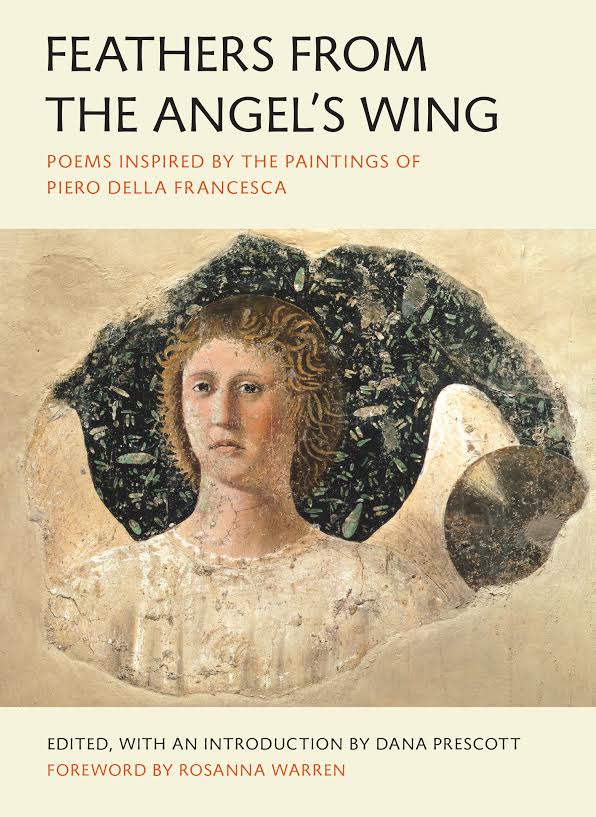Feathers from the Angel’s Wing: Poems Inspired by the Paintings of Piero Della Francesca
edited by Dana Prescott
reviewed by Lisa Mullenneaux
Editor Dana Prescott explains in her introduction to this beautifully designed poetry anthology that she has taken art students, friends, and colleagues across Italy to see Piero della Francesca’s paintings for many years. With this volume, Prescott extends the Piero Trail—a pilgrimage through Umbria, Tuscany, and Le Marche—to armchair travelers, to anyone, in fact, who loves the best of contemporary poetry. We enter landscapes, peopled by mortals and angels, that “tilt so close we could reach out and touch them,” writes Rosanna Warren in her foreword.
Poems are arranged by the cities that house Della Francesca’s works, then by the works themselves. “The Pregnant Madonna,” for example, inspires no fewer than ten tributes, the most famous being Jorie Graham’s “San Sepolcro,” in which the poet recreates a world before Jesus’s birth and invites us in. Graham plays with time, ancient and modern, as the young woman about to undergo labor plays with the buttons of her blue dress. The dress opens—and with it, the tragedy we all know. Moira Egan has a more personal reaction to the Madonna with child:
Long ago, a gypsy predicted
for me two daughters, one dark, one fair.
Grief and guilt come in colors, dull red,
queasy green. I said no to nature,
then nature turned and said no to me.
(“Gravid”)
The strategies these poets use to enter Della Francesca’s works are wildly diverse, but all convey a reverence for the Italian artist’s craftsmanship and simplicity. Albert Goldbarth’s “1400” immerses us in the earthy materials the painter used to create his pigments—“Saps, and the anal grease of an otter, and pig’s blood.” His twenty-seven-line poem is all the more stunning in that it comprises one sentence. Della Francesca’s “The Resurrection” inspires two poems by Gjertrud Schnackenberg. In the first, the painter is a blind old man, reaching to touch his fresco “As if he groped for the lip of a stone coffin.” The same painting of a risen Christ prompts a second poem, “Soldier Asleep at the Tomb,” in which Schnackenberg makes real for us the life of a Roman soldier asleep on his watch:
You dream you run your palm
Across the wall, you dream
You guard an empty place
Where the plaster-crack ascending
Through the air above your face
Has multiplied.
As if a force behind the wall
Were pressing toward you
From the other side.
Mark Wunderlich in “Portrait of Mary Magdalene” compares the subject of Della Francesca’s fresco to prostitutes on the road to Arezzo, who “have set up their stations.” His portrait is that of a farm girl’s “new-found modesty . . . shame already fading as her hair begins to dry . . . ” Such vivid detail also characterizes Rick Barot’s reimagining of Della Francesca’s “The Annunciation.” That moment in which the Angel Gabriel delivers his message to Mary is not a joyful moment but a sober one.
The room a wound,
the light a wing on the floor,the atoms of dust
in the shaft. And the quiet,
that is grief’s appetite.
This collection borrows its title from a line in James Brasfield’s contemplation of Piero’s “The Dream of Constantine,” specifically the appearance of an angel bearing a tiny cross.
I found a feather on a stone, feather I thought
from the angel’s wing, that arc of lightheld aloft in descent, shared with us
and Constantine in his dream.
The poet imagines Della Francesca walking to work across Arezzo cobblestones, watching sunlight pass through shadows,
sunrays warming what they touch.
Piero, first a painter, is not a monk.
He will make what welcomes light
a source of light: slow the day
The anthology ends with Dave King’s joyful memories of the art he visited along the Piero Trail:
In love with curves, a painter conjures circles,
curve on curve, the sockets of the eyes,
round horses’ haunches, thighs as plump as loaves.
We love the form and seek the form in love.
Feathers from the Angel’s Wing joins other important ekphrastic collections, like Ed Hirsch’s Transforming Visions: Writers on Art and Emily Fragos’ Art and Artists: Poems, collections that connect the eye with the word. In selecting her poems, Prescott was guided by their ability to move her and by “the hunger of the writers to grapple with the unresolvable ambiguities of Piero’s paintings.” One of the collection’s strengths is the diversity of these international writers and translators. Contributors include the Mexican poet Jorge Esquinca, the Mongolian writer Mend-Ooyo Gombojav, the late Italian intellectual Pier Paolo Pasolini, and twenty-six others. Their modern responses to this beloved Renaissance painter’s works suggest the depth and timeless quality of his vision.
Published on November 15, 2016

